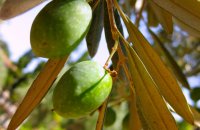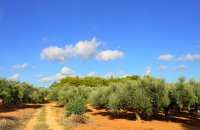




Greece would be different–very different–without the silvery sparkle of her olive trees under the life-giving sun. As the poet Odysseas Elytis observed, the olive, the grapevine, and the boat are what make up Greece.
The many symbolic meanings that accompany the olive tree are not by chance. Its endurance over the passage of time imparts wisdom, and its generous bounty highlights its peaceable disposition. Even as its oil turns any old dish into a gastronomic miracle, you can feel Nature as it cares for you and cures what ails you.
Greek mythology is filled with references to the archetypal importance of the olive tree to Ancient Greece, a symbol of glory, success, and prosperity. The best known is the Pelasgian creation myth, in which the Goddess Athena and the God Poseidon struggle atop the Acropolis for patronage of the newly-founded Athens. The Goddess stabbed her spear into the ground, and planted an olive tree which immediately began to bear fruit, while the god Poseidon struck the ground with his trident and created a spring of salty water. The citizenry adjudged Athena victorious in the contest, named the city after her, and proclaimed the olive to be a sacred plant, even going so far as to legislate its protected status.
The olive has also remained a symbol both of peace and of victory, as the prize for victory in the Olympic games was traditionally a wreath made of the branches of the sacred wild olive. Contemporary Athens, continuing to honor the precious tree, adorned the Olympic torch of the 2004 games with an elegant pattern of its leaves.
The olive also makes an appearance in various religious traditions: a dove brings Noah an olive branch, signifying that the cataclysm is over, and life can continue on the earth. In the Orthodox Christian religion, in the rite of Baptism, the priest anoints the child with olive oil and draws the symbol of the cross upon its forehead. Sailors believe that a few drops of oil added to the lamp illuminating the icon of St. Nicholas have the power to calm rough seas.
Although this hardy tree can be grown in any soil, it has a special affinity for the Mediterranean climate, and thrives here. Olive fruit ripens mid- to late autumn. It changes color from green, to a deep purple, and then to black. Then it will be ready for harvest.
While most crops are harvested using various automated means, olives are traditionally harvested by hand. This traditional harvesting has been the subject of many artistic works, and in our own time, as ‘agrotourism’ takes off, olive harvesting is a perfect fit.
The tree’s branches are combed with a long rake, or beaten with stout wooden threshing-sticks. The fruits are sorted, and then head off either to the oil press, or for curing in oil and vinegar to be packaged and used as whole fruit.
Greece is home to many varieties of olives: Ladolia, Manaki, Coroneic, Athinolia, and more. Some are only suited for oil-making. Some are edible unto themselves, and after a repose in brine for a while, their bitterness will attenuate, and they will go nicely with a meal. Particularly popular are Itea olives and, of course, Kalamata olives whose sub-varieties are seemingly endless.
Hippocrates characterized olive oil as “the Great Healer,” and in his works mentions no fewer than sixty medicinal uses, most importantly in skin care. The softening, hydrating, and antiseptic qualities of olive oil are widely known since antiquity, as apparently they would use it to clean, scent, and hydrate both hair and body. Since the cosmetic and therapeutic uses of olive oil were first identified, circa 4000 B.C., the applications and formulations have proliferated extensively. Soaps, cosmetics, and creams look first to the therapeutic and cosmetic qualities of the oil that is known, deservingly, as “green gold.” The beneficial effects of the olive are not limited to its fruit and its oil, but also extend to its leaves which to this day are used as a botanical against colds, fever, and chronic infection. Its fruit, rich in elements that aid in bone growth, also has anti-inflammatory properties and enhances the immune system. As for the oil, besides the aforementioned starring role in the delicious and nutritious Mediterranean diet, seems to act as a deterrent to the emergence of Alzheimer’s disease. It is no coincidence that the Mediterranean peoples, because of their diet, have lower rates of heart disease. In short, "a teaspoon of oil a day keeps the doctor away."
Is it possible that the secret of the renowned long life of Cretans is hidden in their long tradition of olive cultivation? We see the olive as an ideogram in the tables of Linear A, embossed with great fidelity in the murals of the Minoans, the production of olive oil seems to have been a key element in the flourishing of their civilization. Crete, as it happens, is home to the oldest olive trees in the world, estimated to be more than two thousand years old. One is located in the village of Vouves, in the Kolymbari district of Chania, and the other on the other end of the island at Lasithi, just outside the village of Kavousi. With a circumference of over twelve meters, these trees with their impressive trunks have been declared a natural monument, and attract thousands of visitors each year.
Take a stroll through an olive orchard, let your mind wander amongst the shapes drawn by the centuries-old trunks, relax under their silver-green foliage, and let them introduce you to the Greek landscape.
“My eyes are dazzled, of a July afternoon, by the innumerable slices of sunshine in the waves; that even if there were no such thing as olive trees, a moment like this would require their creation, like a cicada.” —Odysseas Elytis











